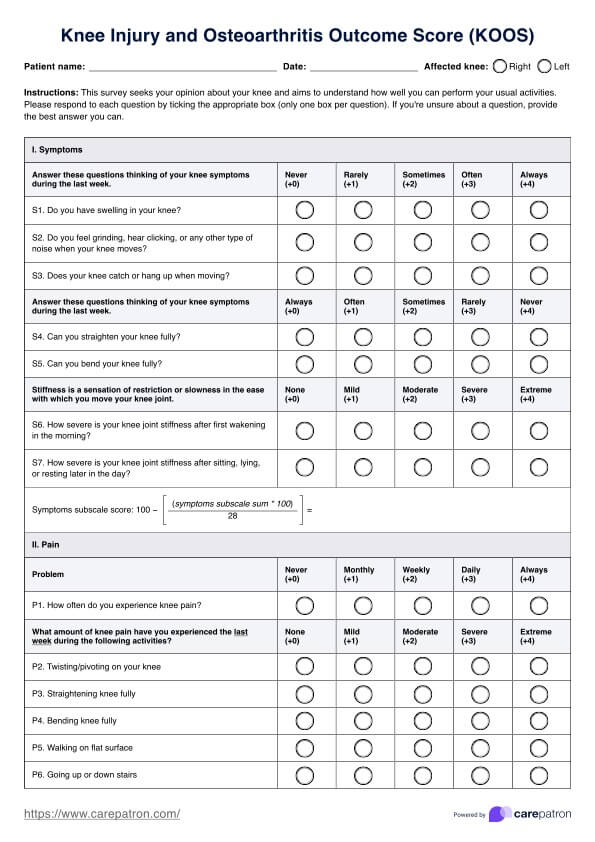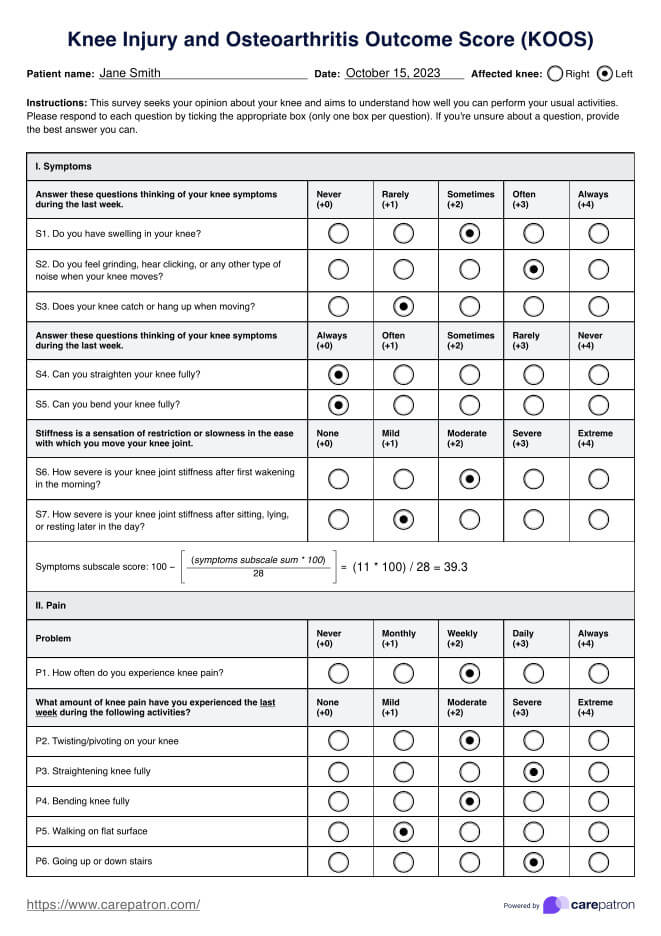KOOS
Discover the essential guide for health professionals on effectively utilizing the Knee Injury and Osteoarthritis Outcome Score (KOOS). A free PDF download with examples is available.


What is the Knee Injury and Osteoarthritis Outcome Score (KOOS)?
The Knee Injury and Osteoarthritis Outcome Score (KOOS) is an advanced self-administered outcome measure developed to assess short-term and long-term symptoms and functions in individuals experiencing various types of knee injuries and osteoarthritis. Created by Roos et al. in 1998, KOOS is tailored to address the unique challenges faced by younger individuals prone to sports injuries and older adults with degenerative joint changes.
KOOS includes five dimensions: pain, symptoms, activities of daily Living (ADL), sports and recreation, and knee-related quality of life. Each section is designed to capture the patient’s perspective on their knee condition, providing a holistic view of the impact on their health and lifestyle. This tool is especially critical for individuals with knee ligament injuries, such as a ruptured anterior cruciate ligament and meniscus injuries, and those undergoing procedures like knee arthroscopy and total knee replacement.
Utilizing KOOS allows healthcare professionals to evaluate the efficacy of medical interventions, such as surgical knee interventions, and to monitor the progression toward recovery or the development of conditions like osteoarthritis. The comprehensive nature of KOOS makes it a vital tool in both clinical settings and research, offering insights into patient-reported outcome measures and enhancing treatment outcomes.
How is it scored?
KOOS scoring involves assigning pre-defined point values to each response, ranging from 0 (no problems) to 4 (extreme problems). Scores are calculated separately for each dimension, with possible scores ranging from 0 to 100, where 100 indicates no knee-related issues, and 0 signifies severe problems.
Next steps after using this score
After scoring, it’s crucial to analyze the results to guide clinical decisions. If a patient reports improvement, the current treatment may continue. However, if scores indicate deterioration, it might prompt a re-evaluation of the treatment strategy, possibly adjusting medications, recommending physical therapy, or considering surgical options.
Healthcare providers can utilize these scores to track changes over time, providing a quantitative measure to assess the effectiveness of treatment plans and adapt them as necessary to optimize patient outcomes.
KOOS Template
KOOS Example
How to use our KOOS template
Our printable KOOS template is designed for ease of use. Healthcare professionals can download and print the template or use it electronically. The template guides the patient through the 42 questions, ensuring all aspects of their knee health are covered.
To use the template effectively:
- Introduce the KOOS as part of the clinical assessment during the patient’s visit.
- Allow the patient to complete the questionnaire, ensuring they understand each question.
- Collect the completed forms and calculate the scores using the provided scoring guide.
- Discuss the results with the patient, address concerns, and plan further actions based on their scores.
This process helps in clinical assessment and engages patients in their care, enhancing their understanding and compliance with treatment regimens.
Benefits of using the KOOS
Utilizing the Knee Injury and Osteoarthritis Outcome Score offers a spectrum of advantages critical to orthopedic practice and research:
Enhanced patient engagement
The KOOS fosters active patient involvement by providing a clear structure for them to express the nuances of their symptoms and functional limits. This active role encourages greater commitment to the treatment regimen, potentially leading to superior outcomes and patient satisfaction.
Detailed monitoring
KOOS facilitates precise and systematic tracking of changes in knee health over time. Whether the patient is recovering from a joint injury, a ruptured anterior cruciate ligament, or managing conditions like knee osteoarthritis, KOOS helps monitor their progress through various treatment phases, from surgery through rehabilitation.
Targeted treatment adjustments
By quantifying the extent of symptoms and functional impairments, KOOS enables healthcare providers to tailor interventions more accurately. Adjustments can be made based on objective data, enhancing the efficacy of treatments for conditions such as meniscus injuries or complications seen in patients undergoing knee arthroscopy.
Research and clinical trials
KOOS is invaluable in clinical studies, providing reliable, patient-reported data on knee health. This makes it an excellent tool for evaluating the effectiveness of new treatments and interventions in a research setting.
Overall, the KOOS is indispensable for clinicians aiming to optimize care and outcomes for patients with knee-related health issues. Its comprehensive approach provides a deeper understanding of patient experiences and treatment impacts, which is essential for advancing orthopedic health strategies.
Reference
Roos EM, Roos HP, Lohmander LS, Ekdahl C, Beynnon BD. Knee Injury and Osteoarthritis Outcome Score (KOOS)--development of a self-administered outcome measure. J Orthop Sports Phys Ther. 1998 Aug;28(2):88-96.
Commonly asked questions
The Injury and Osteoarthritis Outcome Score (KOOS) is suitable for patients who have experienced knee injuries or are managing conditions like osteoarthritis.
The Injury and Osteoarthritis Outcome Score (KOOS) should be used at initial assessment and periodically during treatment to monitor progress.
No, The Injury and Osteoarthritis Outcome Score (KOOS) is freely available, making it accessible to all healthcare providers and researchers.

.jpg)





































































































